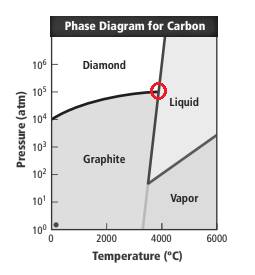
Concept explainers
Interpretation :
Correct option must be chosen regarding the temperature and pressure at which solid graphite, solid diamond and liquid carbon coexists.
Concept Introduction :
Phase diagram gives the idea of different phases at different temperature and pressure. In the phase diagram of carbon, carbon can exit in solid diamond, solid graphite, liquid carbon and vapor phase. There are two triples points; in one point diamond, graphite and liquid carbon exist and in other point graphite liquid and vapor exist.
Answer to Problem 7STP
Correct answer: From the triple point, no option is correct as the point corresponds to
Explanation of Solution
Reason for correct option: The given phase diagram of carbon is represented as follows:

The point marked is triple point where three phases that is diamond, liquid and graphite exist. From the graph it can be seen that this point is at
Thus, none of the option is correct.
Reasons for incorrect options:
In option (a), the pressure and temperature is
In option (b), the pressure and temperature is
In option (c), the pressure and temperature is
In option (d), the pressure and temperature is 80 atm and 3500 K respectively. This cannot be possible as at this low pressure diamond will not exist.
Chapter 12 Solutions
Chemistry: Matter and Change
Additional Science Textbook Solutions
Chemistry: The Central Science (13th Edition)
Inorganic Chemistry
Chemistry: Structure and Properties (2nd Edition)
Organic Chemistry
Chemistry: A Molecular Approach (4th Edition)
General, Organic, and Biological Chemistry (3rd Edition)
 ChemistryChemistryISBN:9781305957404Author:Steven S. Zumdahl, Susan A. Zumdahl, Donald J. DeCostePublisher:Cengage Learning
ChemistryChemistryISBN:9781305957404Author:Steven S. Zumdahl, Susan A. Zumdahl, Donald J. DeCostePublisher:Cengage Learning ChemistryChemistryISBN:9781259911156Author:Raymond Chang Dr., Jason Overby ProfessorPublisher:McGraw-Hill Education
ChemistryChemistryISBN:9781259911156Author:Raymond Chang Dr., Jason Overby ProfessorPublisher:McGraw-Hill Education Principles of Instrumental AnalysisChemistryISBN:9781305577213Author:Douglas A. Skoog, F. James Holler, Stanley R. CrouchPublisher:Cengage Learning
Principles of Instrumental AnalysisChemistryISBN:9781305577213Author:Douglas A. Skoog, F. James Holler, Stanley R. CrouchPublisher:Cengage Learning Organic ChemistryChemistryISBN:9780078021558Author:Janice Gorzynski Smith Dr.Publisher:McGraw-Hill Education
Organic ChemistryChemistryISBN:9780078021558Author:Janice Gorzynski Smith Dr.Publisher:McGraw-Hill Education Chemistry: Principles and ReactionsChemistryISBN:9781305079373Author:William L. Masterton, Cecile N. HurleyPublisher:Cengage Learning
Chemistry: Principles and ReactionsChemistryISBN:9781305079373Author:William L. Masterton, Cecile N. HurleyPublisher:Cengage Learning Elementary Principles of Chemical Processes, Bind...ChemistryISBN:9781118431221Author:Richard M. Felder, Ronald W. Rousseau, Lisa G. BullardPublisher:WILEY
Elementary Principles of Chemical Processes, Bind...ChemistryISBN:9781118431221Author:Richard M. Felder, Ronald W. Rousseau, Lisa G. BullardPublisher:WILEY





